Integration of Task-Based Exoskeleton with an Assist-as-Needed Algorithm for Patient-Centered Elbow Rehabilitation
Abstract
1. Introduction
2. Mechanism Synthesis
3. Exoskeleton Prototype and Materials
4. Proposed Assist-as-Needed Algorithm
4.1. Model Development
| Algorithm 1: Mathematical model training. |
|
4.2. Classification and Assist-as-Needed Strategy
| Algorithm 2: Classification algorithm. |
|
5. Experimental Testing
5.1. Participant Description
5.2. Protocol
5.3. Results
5.4. sEMG Analysis Results
6. Conclusions
Author Contributions
Funding
Institutional Review Board Statement
Informed Consent Statement
Data Availability Statement
Acknowledgments
Conflicts of Interest
Abbreviations
| AAN | Assist-as-Needed |
| DOF | Degree-of-Freedom |
| ROM | Range of Motion |
| sEMG | surface Electromyography |
| RMS | Root-Mean-Square |
| AMC | Acceptable Muscle Contraction |
| MVC | Maximum Voluntary Contraction |
| FSR | Force Sensing Resistor |
| API | Application Programming Interface |
| SDK | Software Development Kit |
| CPRF | Central Palsy Research Foundation |
References
- Sacco, R.L.; Kasner, S.E.; Broderick, J.P.; Caplan, L.R.; Connors, J.; Culebras, A.; Elkind, M.S.; George, M.G.; Hamdan, A.D.; Higashida, R.T.; et al. An updated definition of stroke for the 21st century: A statement for healthcare professionals from the American Heart Association/American Stroke Association. Stroke 2013, 44, 2064–2089. [Google Scholar] [CrossRef] [PubMed]
- Clarke, P.J.; BLACK, S.E.; Badley, E.M.; Lawrence, J.M.; Ivan Williams, J. Handicap in stroke survivors. Disabil. Rehabil. 1999, 21, 116–123. [Google Scholar] [CrossRef] [PubMed]
- Millett, P.J.; Wickiewicz, T.L.; Warren, R.F. Motion loss after ligament injuries to the knee: Part I: Causes. Am. J. Sport. Med. 2001, 29, 664–675. [Google Scholar] [CrossRef] [PubMed]
- Koh, K.H.; Lim, T.K.; Lee, H.I.; Park, M.J. Surgical treatment of elbow stiffness caused by post-traumatic heterotopic ossification. J. Shoulder Elb. Surg. 2013, 22, 1128–1134. [Google Scholar] [CrossRef]
- McCabe, R.A.; Nicholas, S.J.; Montgomery, K.D.; Finneran, J.J.; McHugh, M.P. The effect of rotator cuff tear size on shoulder strength and range of motion. J. Orthop. Sport. Phys. Ther. 2005, 35, 130–135. [Google Scholar] [CrossRef]
- Langhorne, P.; Coupar, F.; Pollock, A. Motor recovery after stroke: A systematic review. Lancet Neurol. 2009, 8, 741–754. [Google Scholar] [CrossRef]
- Kyrarini, M.; Lygerakis, F.; Rajavenkatanarayanan, A.; Sevastopoulos, C.; Nambiappan, H.R.; Chaitanya, K.K.; Babu, A.R.; Mathew, J.; Makedon, F. A survey of robots in healthcare. Technologies 2021, 9, 8. [Google Scholar] [CrossRef]
- Lee, M.H.; Siewiorek, D.P.; Smailagic, A.; Bernardino, A.; Badia, S.B. Towards personalized interaction and corrective feedback of a socially assistive robot for post-stroke rehabilitation therapy. In Proceedings of the 2020 29th IEEE International Conference on Robot and Human Interactive Communication (RO-MAN), Naples, Italy, 31 August–4 September 2020; IEEE: Piscataway, NJ, USA, 2020; pp. 1366–1373. [Google Scholar]
- Cui, X.; Chen, W.; Jin, X.; Agrawal, S.K. Design of a 7-DOF cable-driven arm exoskeleton (CAREX-7) and a controller for dexterous motion training or assistance. IEEE/ASME Trans. Mechatron. 2016, 22, 161–172. [Google Scholar] [CrossRef]
- Christensen, S.; Bai, S. Kinematic analysis and design of a novel shoulder exoskeleton using a double parallelogram linkage. J. Mech. Robot. 2018, 10, 041008. [Google Scholar] [CrossRef]
- Li, L.; Han, J.; Li, X.; Guo, B.; Wang, X.; Du, G. A novel end-effector upper limb rehabilitation robot: Kinematics modeling based on dual quaternion and low-speed spiral motion tracking control. Int. J. Adv. Robot. Syst. 2022, 19, 17298806221118855. [Google Scholar] [CrossRef]
- Yihun, Y.; Adhikari, V.; Majidirad, A.; Desai, J. Task-based knee rehabilitation with assist-as-needed control strategy and recovery tracking system. J. Eng. Sci. Med. Diagn. Ther. 2020, 3, 021110. [Google Scholar] [CrossRef]
- Frank Lopresti, E.; Mihailidis, A.; Kirsch, N. Assistive technology for cognitive rehabilitation: State of the art. Neuropsychol. Rehabil. 2004, 14, 5–39. [Google Scholar] [CrossRef]
- Mehdi, H.; Boubaker, O. Stiffness and impedance control using Lyapunov theory for robot-aided rehabilitation. Int. J. Soc. Robot. 2012, 4, 107–119. [Google Scholar] [CrossRef]
- George, J.A.; Gunnell, A.J.; Archangeli, D.; Hunt, G.; Ishmael, M.; Foreman, K.B.; Lenzi, T. Robust torque predictions from electromyography across multiple levels of active exoskeleton assistance despite non-linear reorganization of locomotor output. Front. Neurorobotics 2021, 15, 700823. [Google Scholar] [CrossRef] [PubMed]
- Hu, B.; Zhang, F.; Lu, H.; Zou, H.; Yang, J.; Yu, H. Design and assist-as-needed control of flexible elbow exoskeleton actuated by nonlinear series elastic cable driven mechanism. Actuators 2021, 10, 290. [Google Scholar] [CrossRef]
- Delgado, P.; Arachchige Don, T.A.; Gomez, J.; Miranda, V.; Yihun, Y. Design of bio-exoskeleton for elbow rehabilitation. In Proceedings of the Frontiers in Biomedical Devices; American Society of Mechanical Engineers: New York City, NY, USA, 2021; Volume 84812, p. V001T10A002. [Google Scholar]
- Baker, J.E. The Bennett linkage and its associated quadric surfaces. Mech. Mach. Theory 1988, 23, 147–156. [Google Scholar] [CrossRef]
- Palazzi, E.; Luzi, L.; Dimo, E.; Meneghetti, M.; Vicario, R.; Luzia, R.F.; Vertechy, R.; Calanca, A. An Affordable Upper-Limb Exoskeleton Concept for Rehabilitation Applications. Technologies 2022, 10, 22. [Google Scholar] [CrossRef]
- Abdelbar, M.; Mohamed, I.; Abdellatif, A.; Hegaze, M.M. Towards the Mechatronic Development of a New Upper-Limb Exoskeleton (SAMA). Designs 2022, 6, 80. [Google Scholar] [CrossRef]
- Li, S.; Wang, Z.; Pang, Z.; Duan, Z.; Gao, M. Design and analysis of an upper limb exoskeleton robot for stroke rehabilitation. In Proceedings of the 2022 IEEE International Conference on Real-time Computing and Robotics (RCAR), Guiyang, China, 17–22 July 2022; IEEE: Piscataway, NJ, USA, 2022; pp. 573–578. [Google Scholar]
- Bottlang, M.; Madey, S.; Steyers, C.; Marsh, J.; Brown, T.D. Assessment of elbow joint kinematics in passive motion by electromagnetic motion tracking. J. Orthop. Res. 2000, 18, 195–202. [Google Scholar] [CrossRef]
- Delgado, P.; Rincon, C.; Yihun, Y. Human-Exoskeleton Joint Coordination Assessment: A Case Study on the Shoulder and Elbow Joints. J. Bionic Eng. 2022, 19, 1712–1721. [Google Scholar] [CrossRef]
- Yaniger, S. Force sensing resistors: A review of the technology. In Proceedings of the Electro International, New York, NY, USA, 16–18 April 1991; IEEE: Piscataway, NJ, USA, 1991; pp. 666–668. [Google Scholar]
- Leng, L.; Zhang, T.; Kleinman, L.; Zhu, W. Ordinary least square regression, orthogonal regression, geometric mean regression and their applications in aerosol science. In Proceedings of the Journal of Physics: Conference Series; IOP Publishing: Bristol, England, 2007; Volume 78, p. 012084. [Google Scholar]
- Altman, D.G.; Bland, J.M. Standard deviations and standard errors. BMJ 2005, 331, 903. [Google Scholar] [CrossRef] [PubMed]
- McDonald, J.W.; Sadowsky, C. Spinal-cord injury. Lancet 2002, 359, 417–425. [Google Scholar] [CrossRef] [PubMed]
- Duan, D.; Goemans, N.; Takeda, S.; Mercuri, E.; Aartsma-Rus, A. Duchenne muscular dystrophy. Nat. Rev. Dis. Prim. 2021, 7, 1–19. [Google Scholar] [CrossRef]
- Caulcrick, C.; Huo, W.; Hoult, W.; Vaidyanathan, R. Human joint torque modelling with MMG and EMG during lower limb human-exoskeleton interaction. IEEE Robot. Autom. Lett. 2021, 6, 7185–7192. [Google Scholar] [CrossRef]
- Konrad, P. The abc of emg. In A Practical Introduction to Kinesiological Electromyography; Noraxon U.S.A. Inc.: Scottsdale, AZ, USA, 2005; Volume 1, pp. 30–35. [Google Scholar]
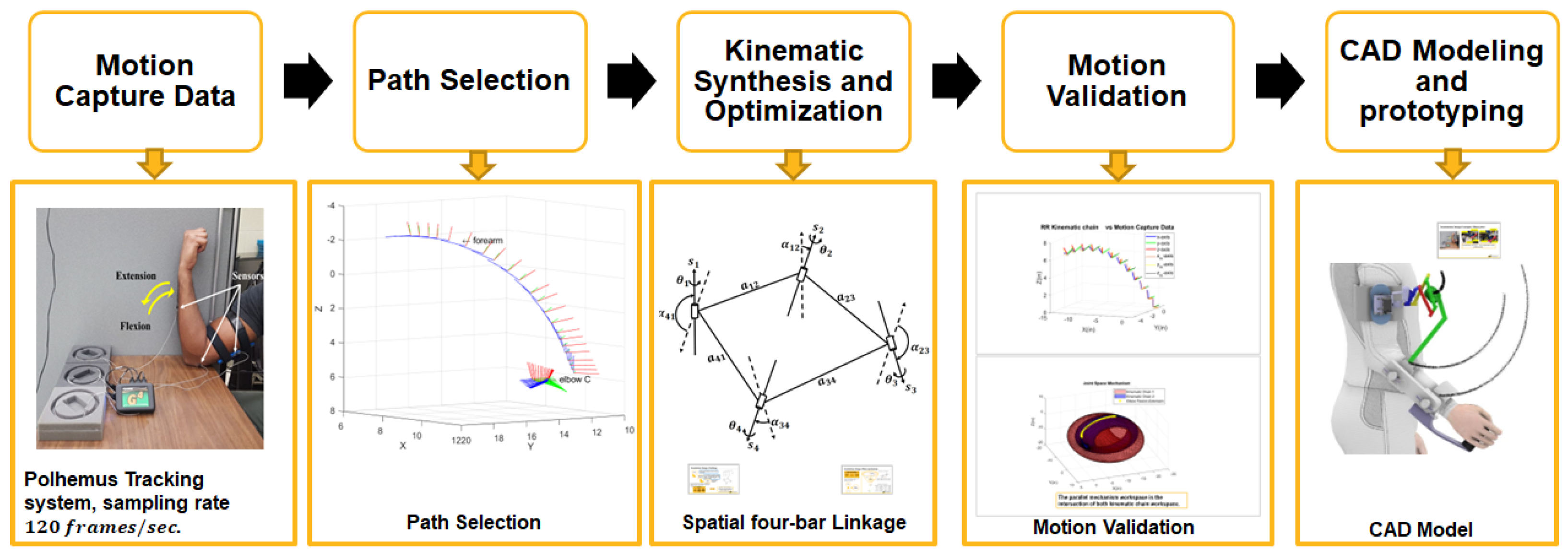
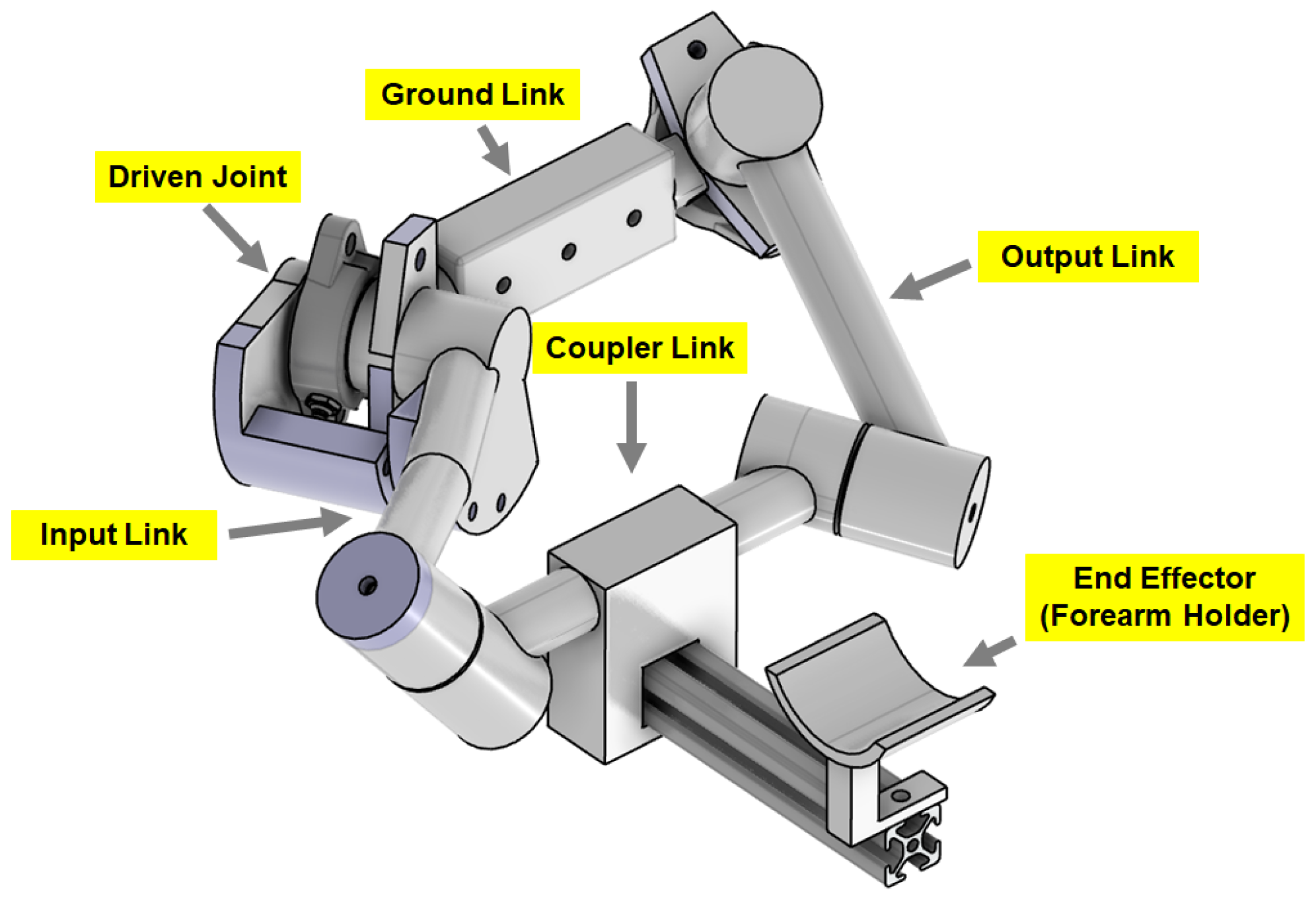
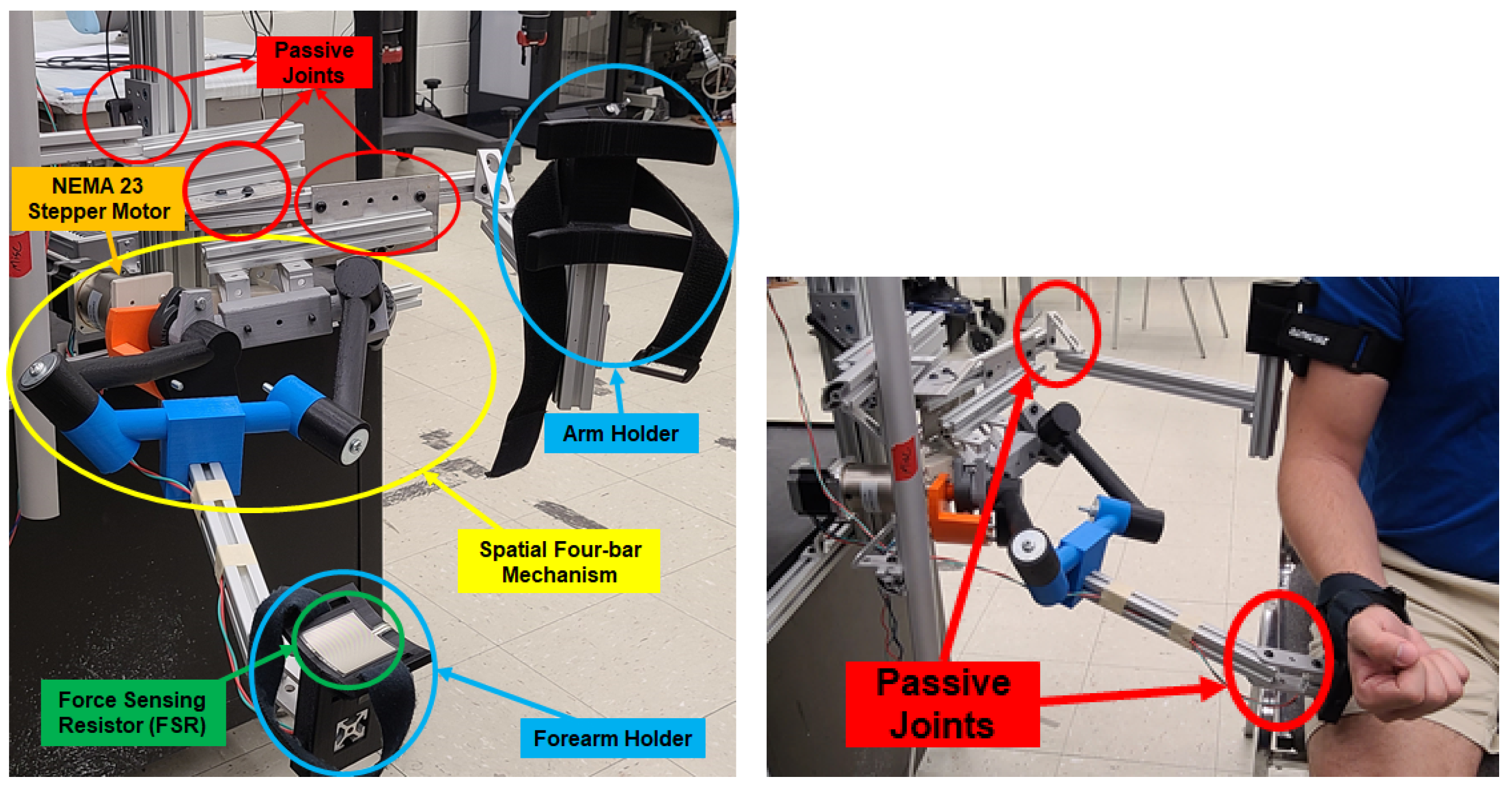


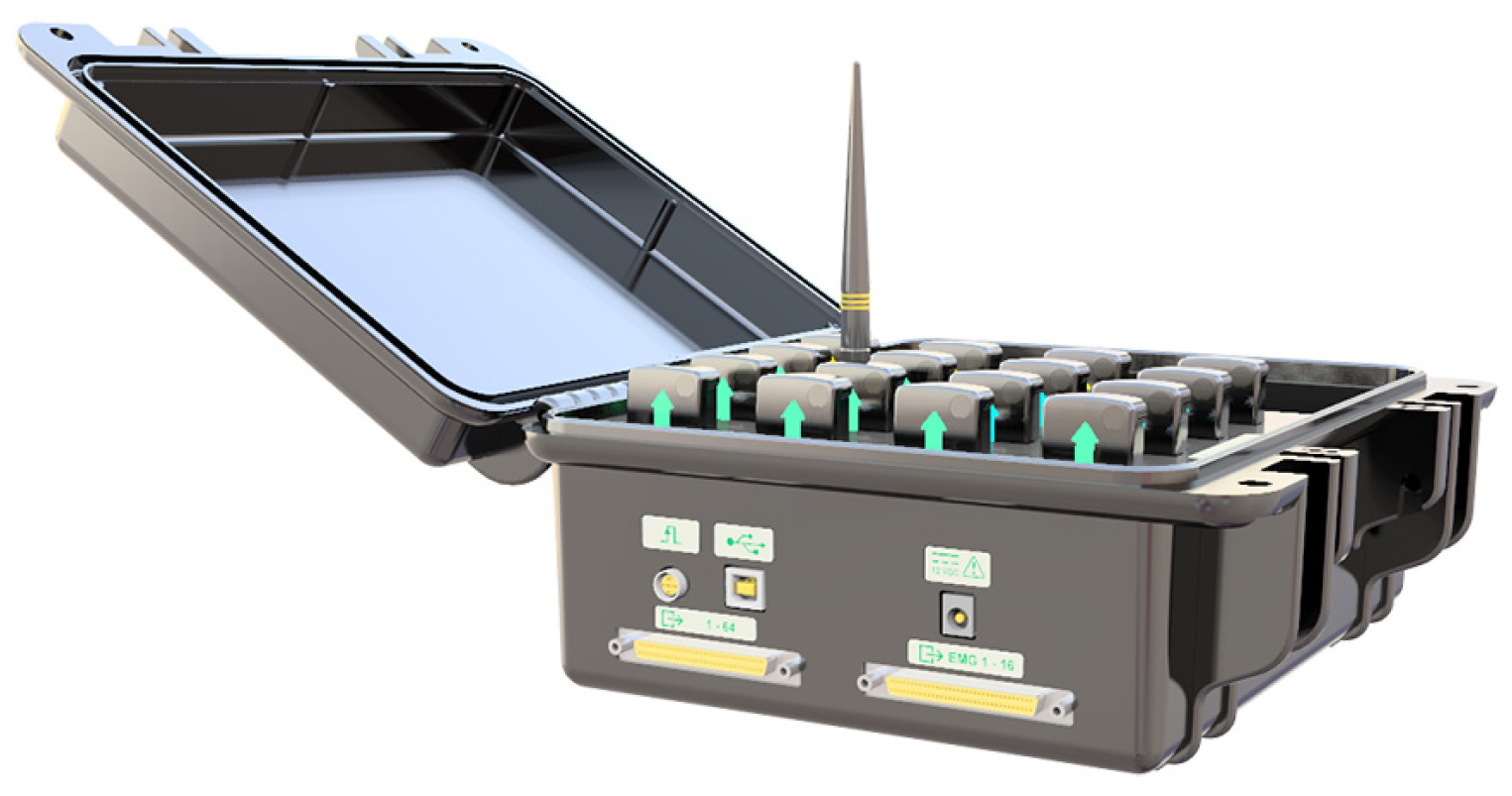

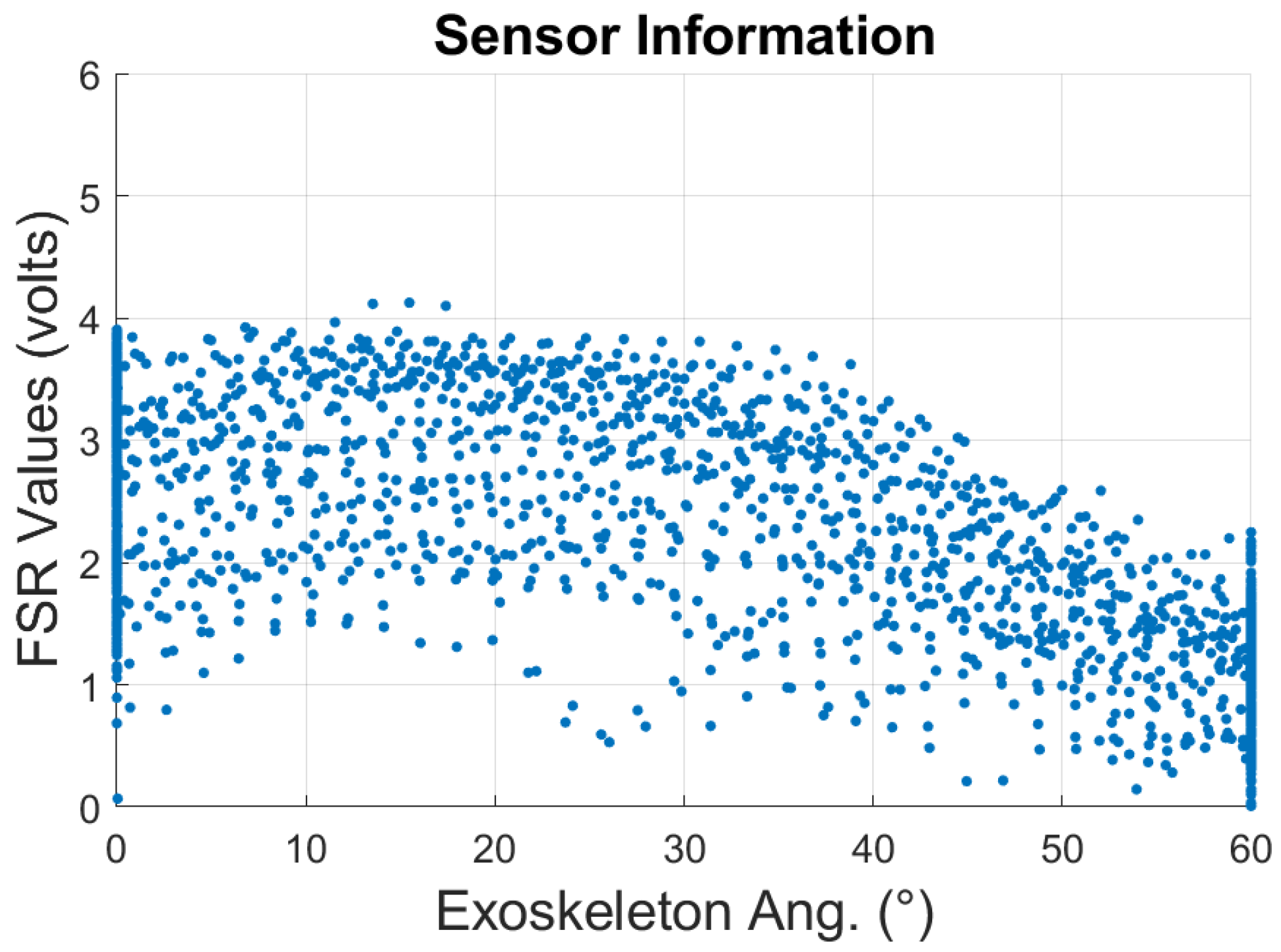
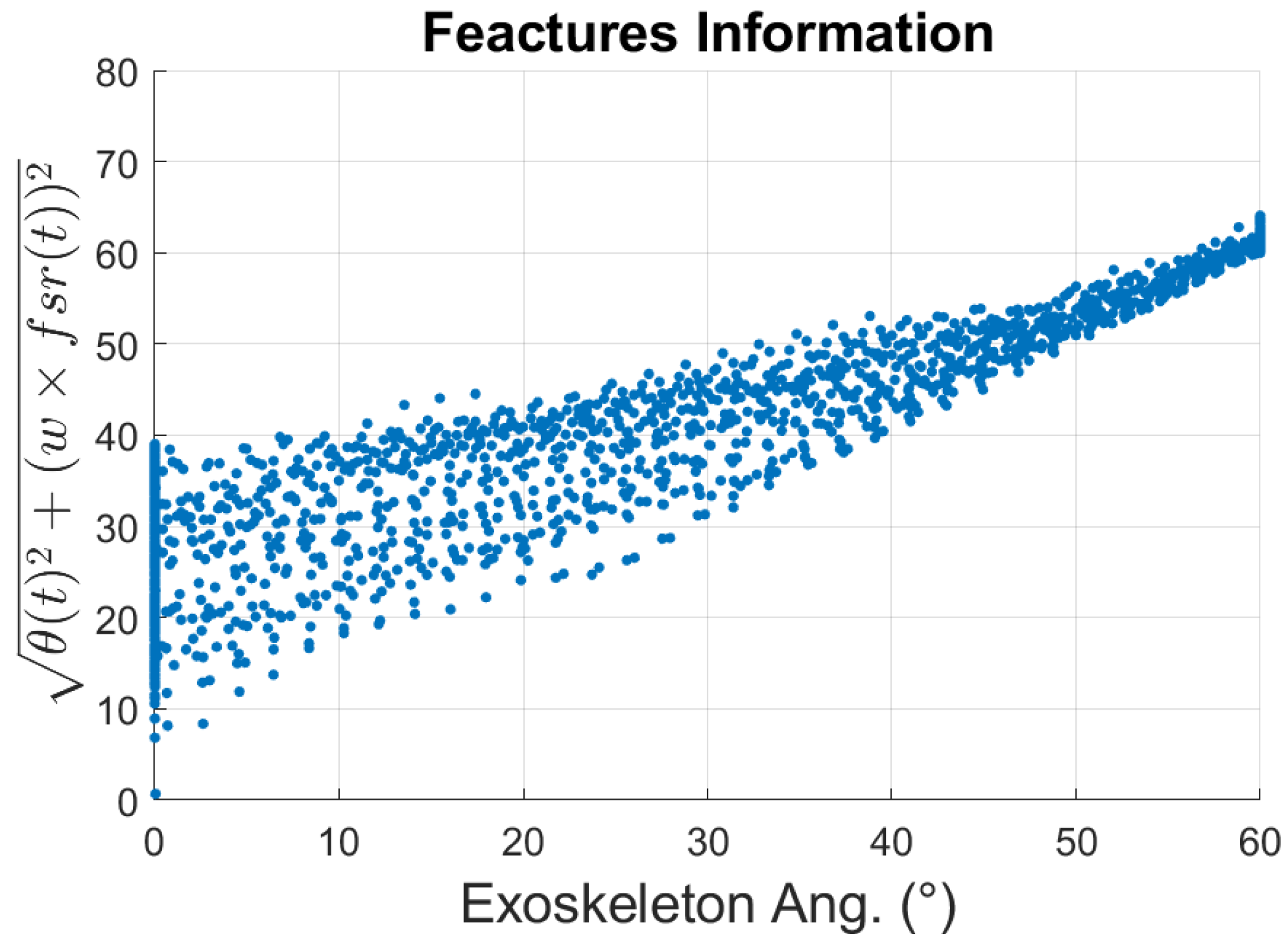
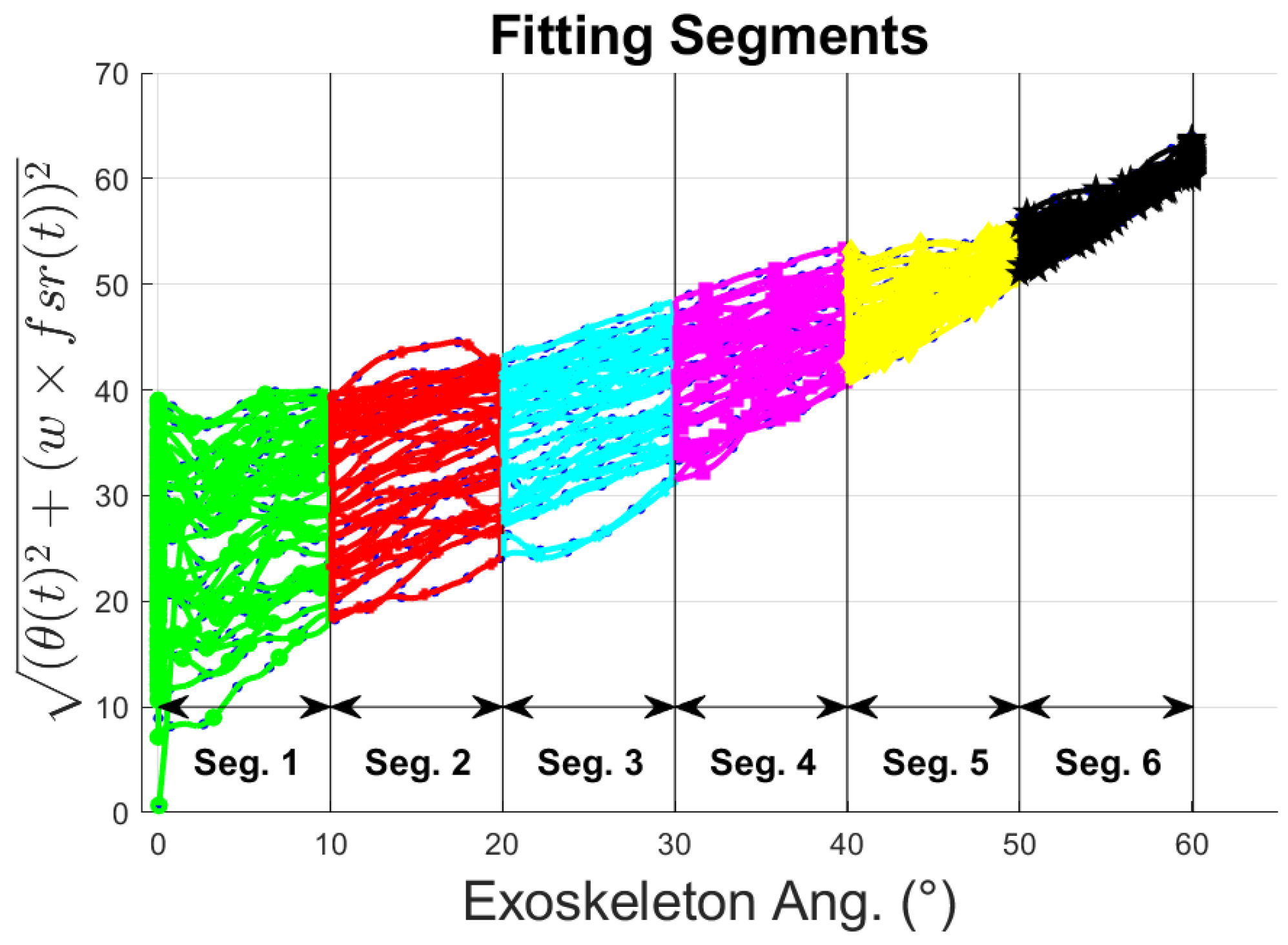

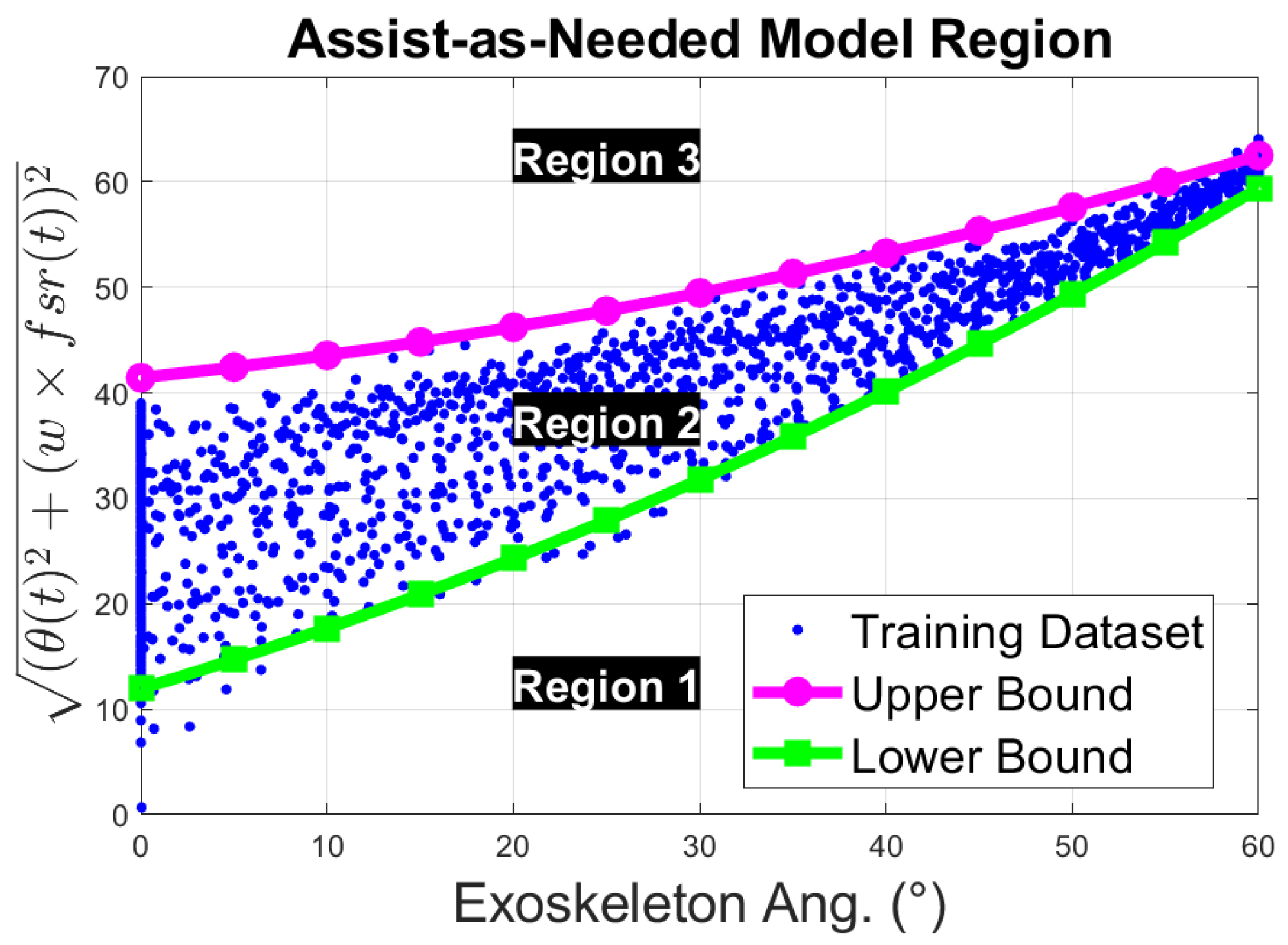
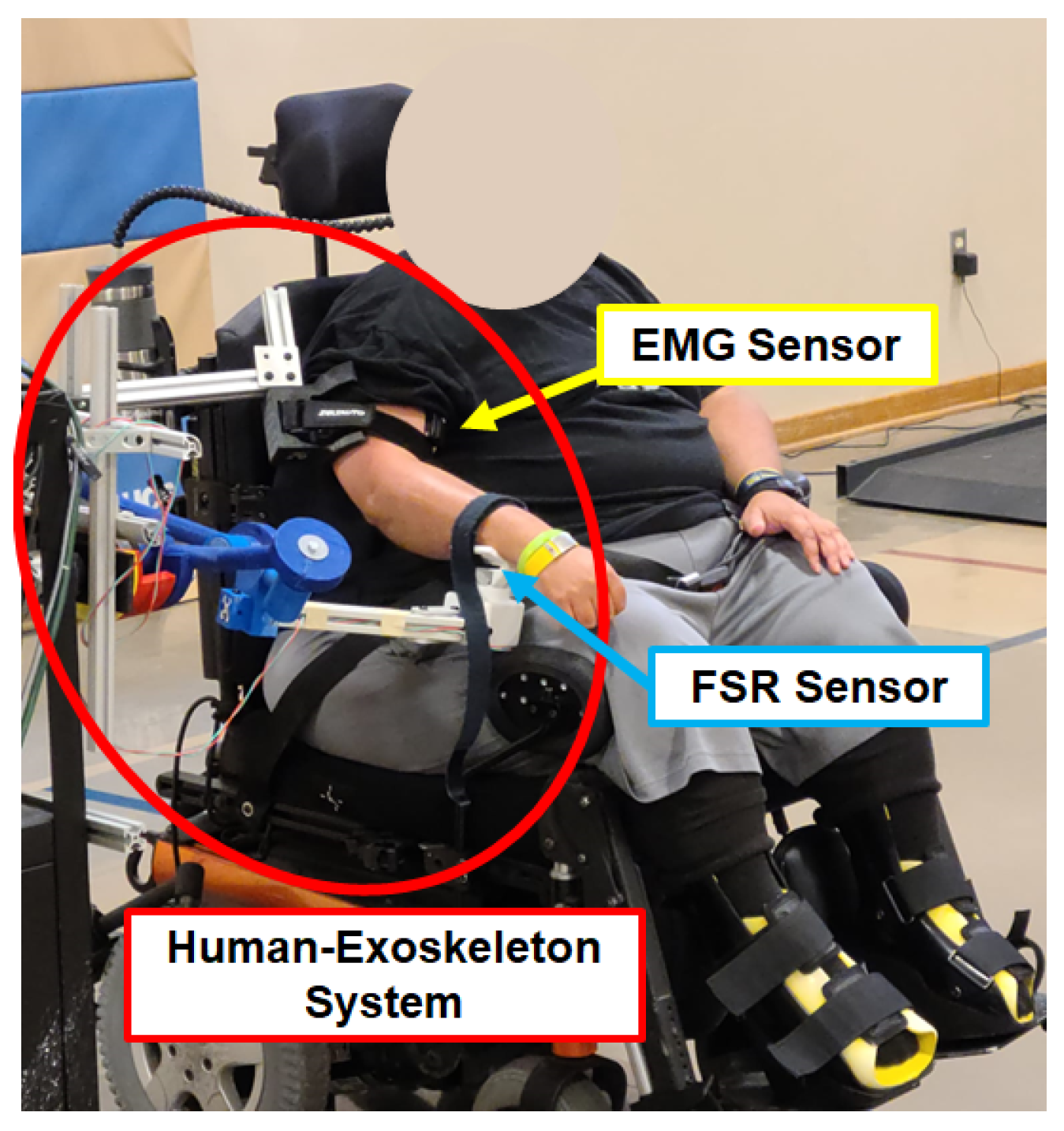

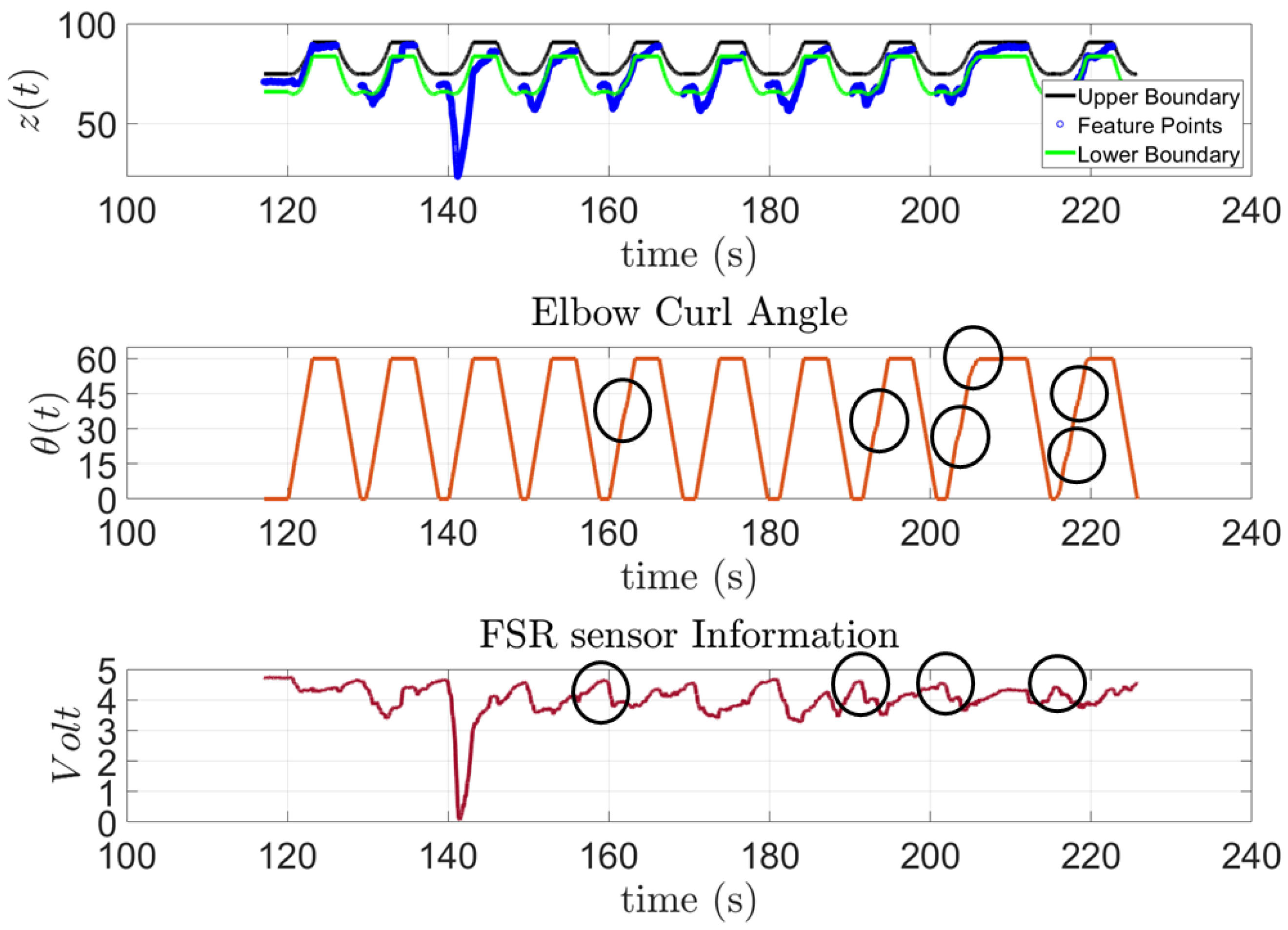
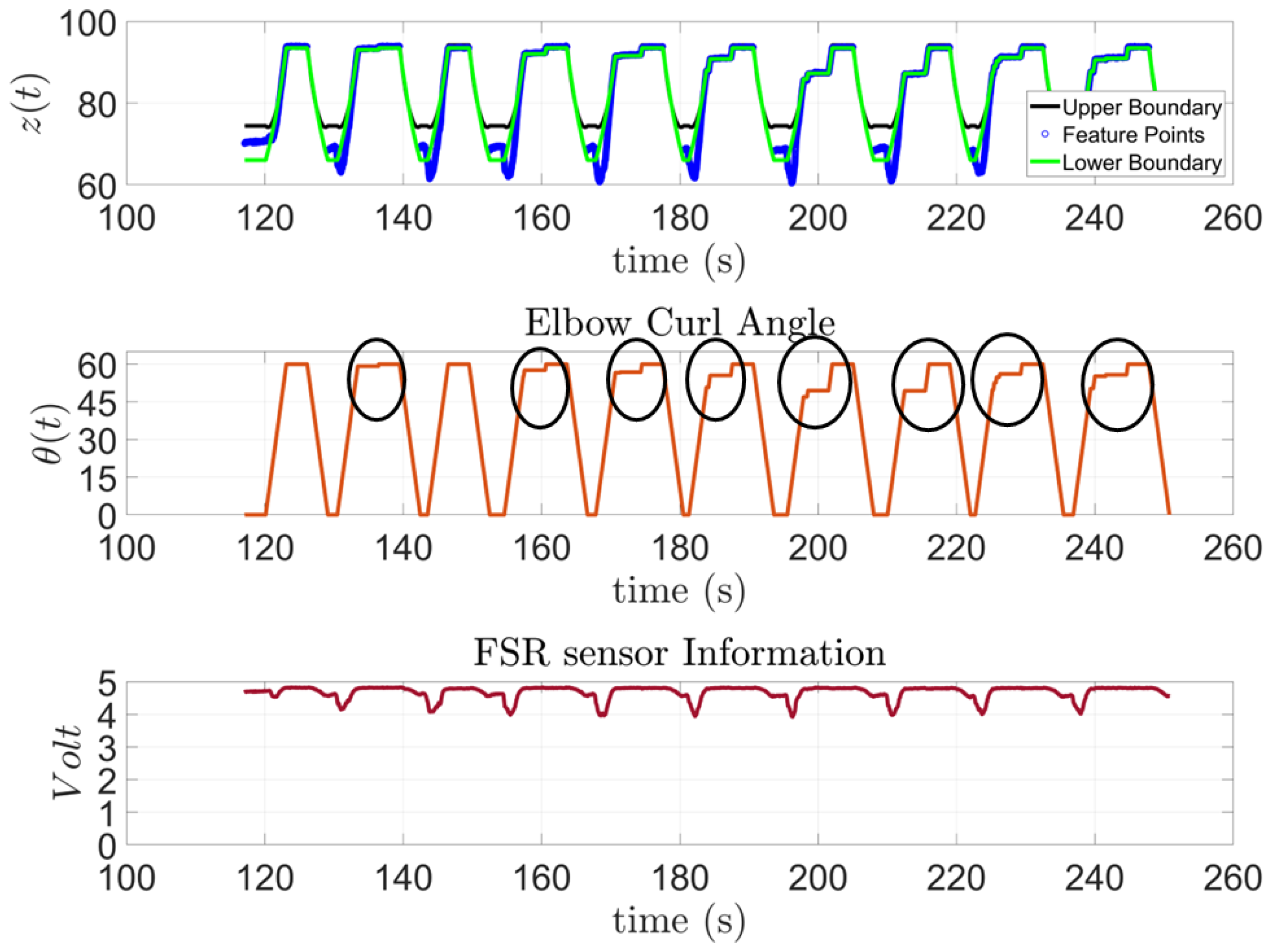

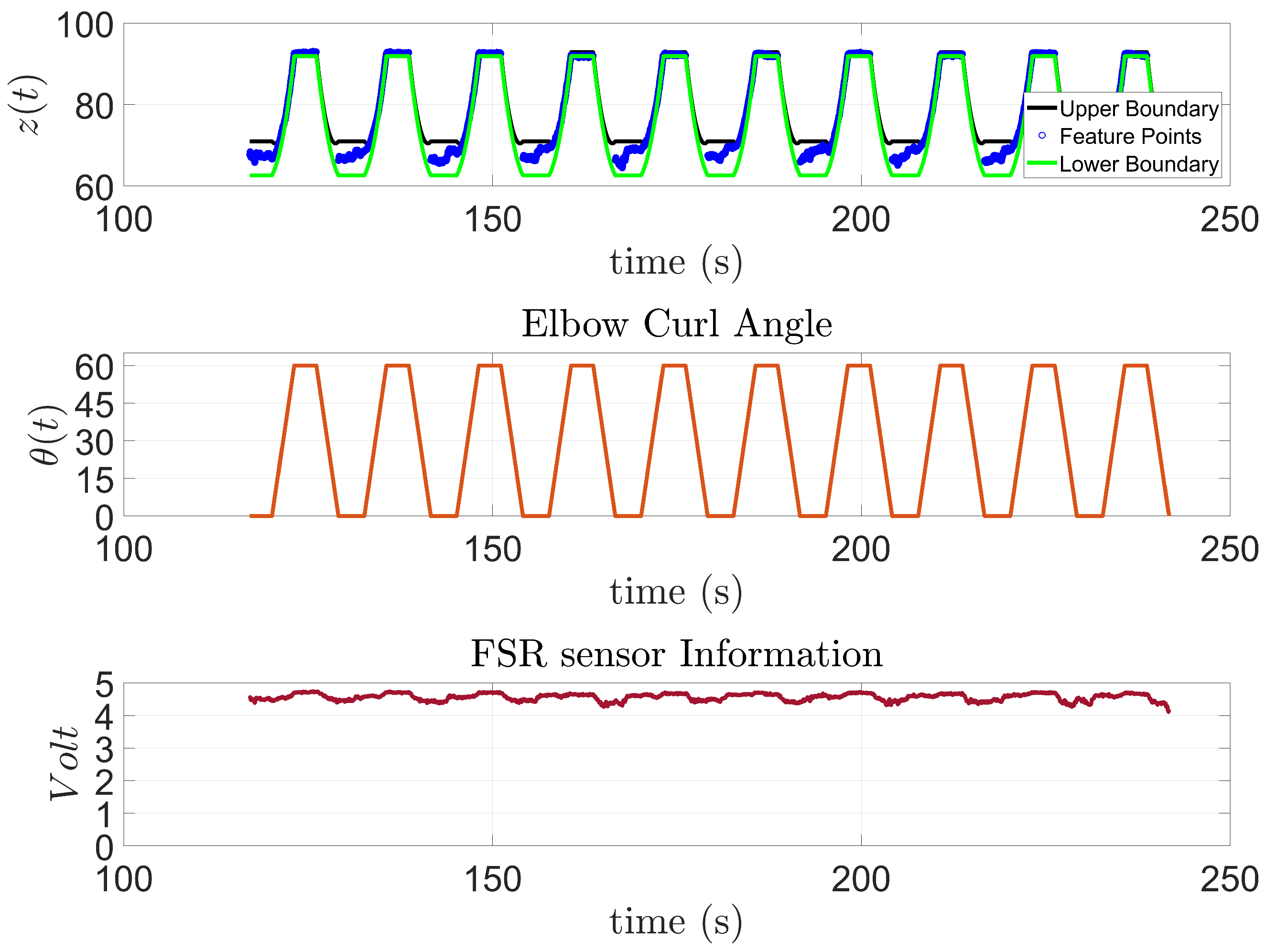
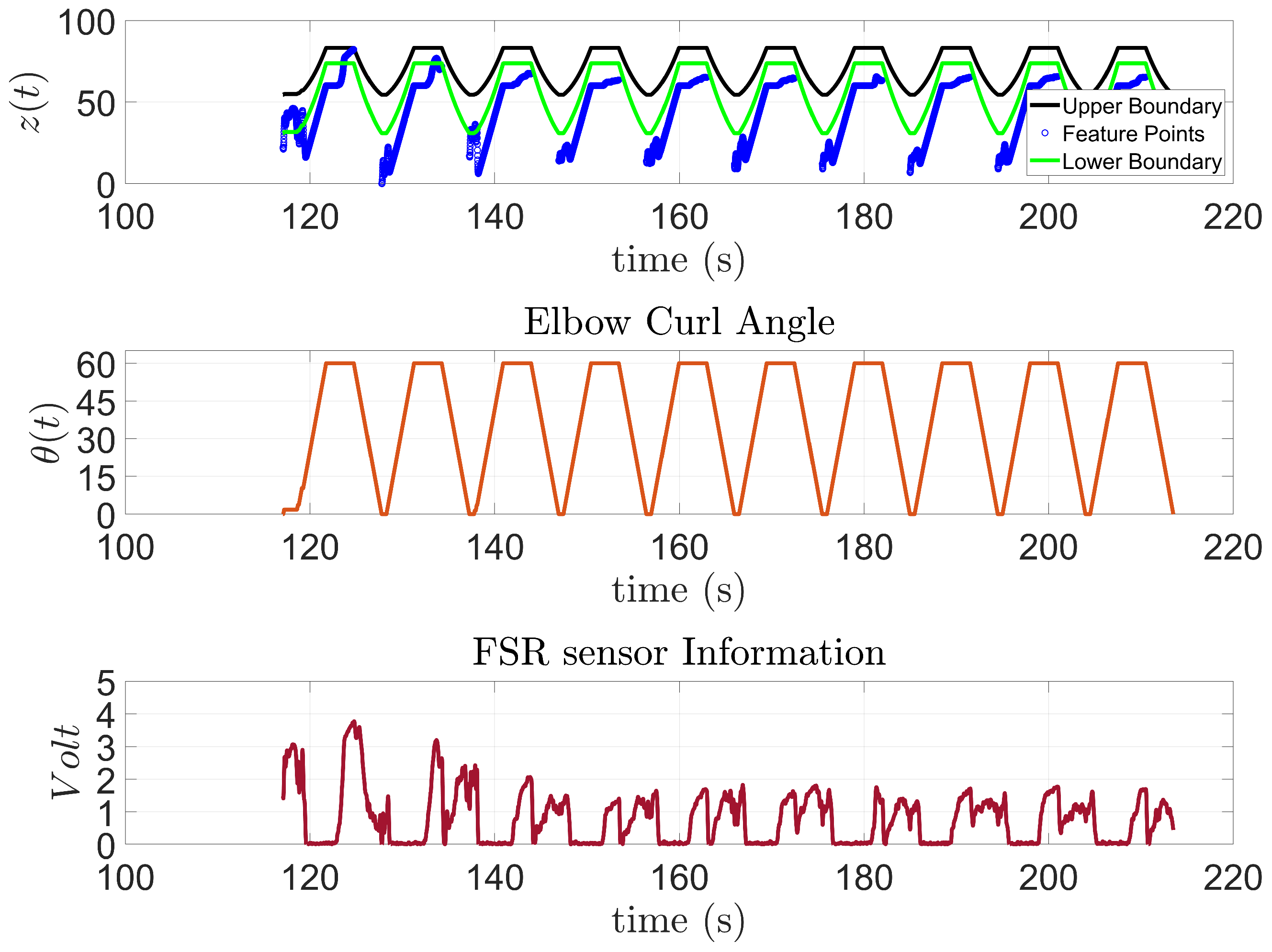


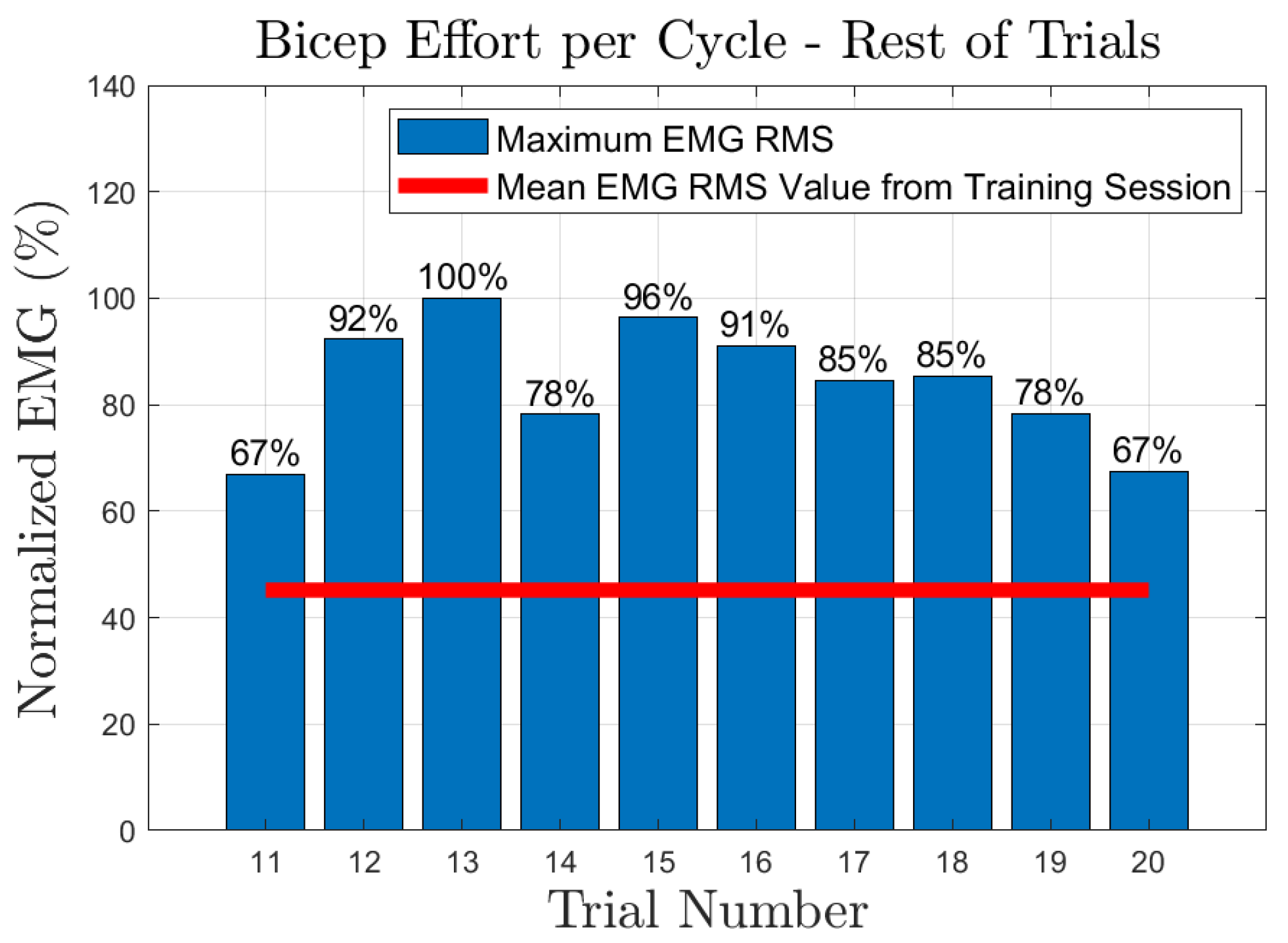
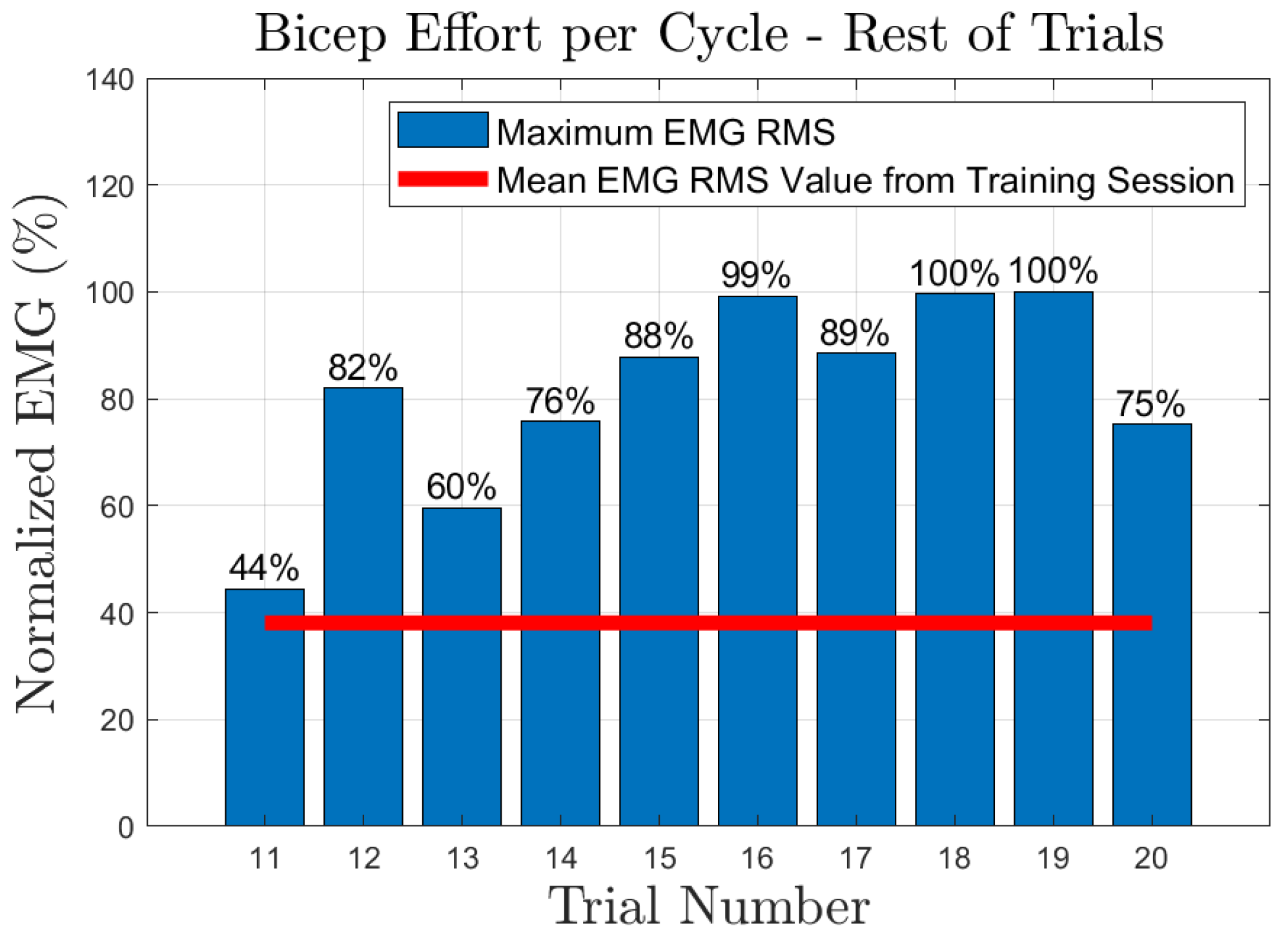

| Subject | 1 | 2 | 3 | 4 | 5 |
|---|---|---|---|---|---|
| Model Accuracy | 96.85% | 77.91% | 94.61% | 93.82% | 92.91% |
Disclaimer/Publisher’s Note: The statements, opinions and data contained in all publications are solely those of the individual author(s) and contributor(s) and not of MDPI and/or the editor(s). MDPI and/or the editor(s) disclaim responsibility for any injury to people or property resulting from any ideas, methods, instructions or products referred to in the content. |
© 2023 by the authors. Licensee MDPI, Basel, Switzerland. This article is an open access article distributed under the terms and conditions of the Creative Commons Attribution (CC BY) license (https://creativecommons.org/licenses/by/4.0/).
Share and Cite
Delgado, P.; Yihun, Y. Integration of Task-Based Exoskeleton with an Assist-as-Needed Algorithm for Patient-Centered Elbow Rehabilitation. Sensors 2023, 23, 2460. https://doi.org/10.3390/s23052460
Delgado P, Yihun Y. Integration of Task-Based Exoskeleton with an Assist-as-Needed Algorithm for Patient-Centered Elbow Rehabilitation. Sensors. 2023; 23(5):2460. https://doi.org/10.3390/s23052460
Chicago/Turabian StyleDelgado, Pablo, and Yimesker Yihun. 2023. "Integration of Task-Based Exoskeleton with an Assist-as-Needed Algorithm for Patient-Centered Elbow Rehabilitation" Sensors 23, no. 5: 2460. https://doi.org/10.3390/s23052460
APA StyleDelgado, P., & Yihun, Y. (2023). Integration of Task-Based Exoskeleton with an Assist-as-Needed Algorithm for Patient-Centered Elbow Rehabilitation. Sensors, 23(5), 2460. https://doi.org/10.3390/s23052460







